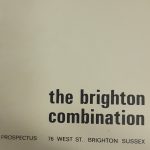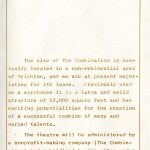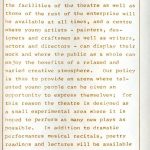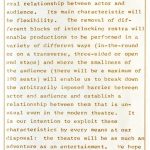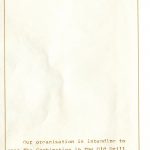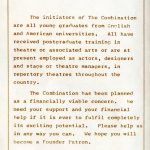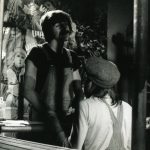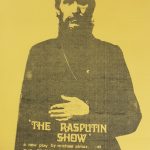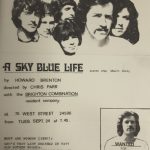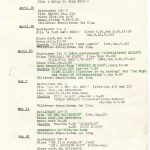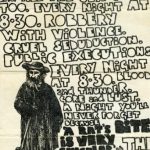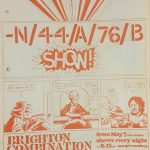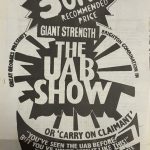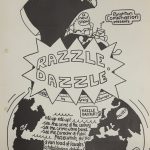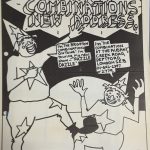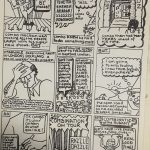Company name: Brighton Combination
Founders: Noel Greig, Jenny Harris, Ruth Marks
Established: 1968
Reason: To establish an Arts Lab set up outside London
Current status: In 1971 the company moved to East London to become part of the Albany Empire (as The Combination at The Albany i.e. ‘The Old Albany’ in Creek Road, later replaced, after it was burnt down, by The Albany Empire, later The Albany in Douglas Way, Deptford).
The Combination continued forward until 1990.
Area of Work: Political, New Writing, Community
Policy: ‘The theatre will be administrated by a non-profit-making company (The Combination) and subsidised by its other under-takings which will comprise a second limited company (Brighton Combination Limited) which will run the art gallery and coffee shop and sub-let the other four galleries.’ (Brighton Combination Prospectus 1968)
It was however, always a central plank of policy that Brighton Combination would put young people at the heart of the operation: ‘…it was for a different demographic, different audience, younger people […] You know, working class people, I mean, kids. We were trying to completely deconstruct theatre and reconstruct it again in what we now remember as Studio Theatres and what we would now call ‘site-specific’ and what we would now call ‘outdoor festivals’ and ‘street art’ and ‘street shows’ and getting people involved. Getting people making what we’d now call Youth Theatre.’ (Tony Coult interview with Jenny Harris)
Structure: Collective
Based: 76, West Street, Brighton
Funding: Arts Council funding
Performance Venues: Brighton Combination, Arts Theatre, Drury Lane Arts Lab and touring to universities, colleges and various Trade Union organisations.
Audiences: Local people especially young people, national alternative theatre practitioners and their audiences, students, Trade Unionists
Company work and process: The Brighton Combination was established by friends, Jenny Harris, Ruth Marks and Noel Greig, in 1968, in an old Victorian School, 76 West Street, in Brighton. They were inspired by Jim Haynes‘ Art Lab in Drury Lane –’ its ambiance, ethos, a place where film, poetry, theatre, art were taking place around the clock’ (Noel Greig) – and other new works that were ‘happening’ in the US and the UK (Traverse in Edinburgh, Little Theatre St Martin’s Lane, Inter-Action) at time. As the Drury Lane Arts Lab was already up and running in London they decided on a location out of town.
Their main income came from the café, which they ran and managed along with everything else: theatre, discos, films and poetry readings. They ‘…were looking to find a context for theatre to happen that wasn’t in a conventional performance space.’ (Noel Greig) The Brighton Combination was the first alternative theatre company that had its own building with its own ensemble.
Their work was deeply involved with the Left alternative culture. Unusually for the time it was run by two women and one gay man.
Combination members included Elyse Dodgson, Katya Benjamin, John Turner, Richard Crane, Chris Parr, John Grillo, Tim Davies, Johnny Dodgson, Katie Heyland, Jim Carter and Howard Brenton, who became their resident playwright thanks to some Arts Council funding.
Many of the early alternative companies toured there: Portable Theatre, People Show, Incubus, Wherehouse La MaMa, Freehold and Inter-Action. One of their first productions was Michael Almaz’s The Rasputin Show which got national attention, helped very much through their friendship with locally-based reviewer Jack Tinker. The play transferred to The Arts Theatre the same year, 1968.
The plays were radical such as The Rise and Fall of Tony Banana, about Cuba, the British and the police. Produced by Elyse Dodgson, it toured to universities including a performance in the middle of the night at a LSE sit-in. The highly successful National Assistance Board (NAB) Play, was in the Joan Littlewood mould, looking at social security. It toured nationally to claimants’ unions. Razzle Dazzle, co-written by John Turner and Noel Greig was about the police, and of the company devised The Don’t Come Show, a critique of where theatre was at at the time, ‘David Hare said it was the quintessential 60s play.’ (Noel Greig)
Their experiences of touring got them thinking about who they were playing to and wanted to play to. Performances included one at the Albany, Deptford. In 1971 an advert appeared in the Guardian for two arts workers at The Albany which Noel Greig and Jenny Harris applied for. Securing a deal to bring the whole company, ethos and structure with them to The Albany, they transferred there later that year, becoming The Combination. Company members at that time included: John Turner, Tina Jones, Marcel Steiner.
The Combination
From the Alternative Theatre Handbook, 1975-76:
‘The Combination work in Deptford and aim to bring live entertainment to an area that is totally deprived – culturally, educationally, socially.’
Tours: ‘Only tour locally – pubs etc. Very occasionally to other London venues.’
Other activities: ‘Holiday play schemes: local schools drama festival; short ‘issue’ based plays for local groups.’
John Turner: ‘Noel left the company in 1971. John Redman became director as well as designer for Watch it all Come Down by me about redevelopment and the demolition industry. [There was] a great exploding wardrobe built by John Redman at the climax of the show. Once it was a bit too great we blew the clock off the wall at Swindon Arts Centre.
I invented the name Albany Empire for the Albany Hall. I hoped the name would borrow some of the roots of the New Cross Empire the local music hall which had closed in the sixties. It maybe that we dropped the name Brighton Combination in 1971. We did move from Brighton to Deptford around then. But when our publicity material did change we used the name Combination on Tour. Later the Combination at the Albany Empire. Jenny and I left the company in 1985, but the company with Marcel Steiner on the board still called itself the Combination till 1990.’
You will find more information on the Brighton Combination on our Noel Greig webpage and more on the Albany work on Kate Owen‘s page.
Personal appraisals:
Noel Greig:‘There were two friends of mine at university, two women friends of mine, one called Ruth Marks and a woman called Jenny Harris. And they’d been up to Edinburgh, to the Edinburgh Festivals and seen some of the stuff that was going on in Edinburgh which was happening ’65 – ’66. You know, the Traverse and the Happenings… and they were very excited about that. And we had had conversations about wouldn’t it be interesting if we just did something of our own. And we’d had sort of conversations like that at university, but in a very sort of unformed way. And then while I was actually up in Harrogate and Oldham [in rep] things were beginning to happen a bit more in London and places. And we’d had more of these conversations, and then that year we decided that we’d set up something of our own, and we moved to Brighton at the end of 1967. We’d found this old Victorian school house just off West Street just before the promenade, up a little alley. And we sort of got it for a peppercorn rent. A little Victorian school house and some outhouses, and we turned it into – we called it the Brighton Combination – we turned it into an Arts Lab on nothing. We converted this building. We had a room that was going to be the theatre, quite a large room, and we had small rooms with other things happening, but we had a cafe and that’s where we made our money…You’d go in in the morning, early, you’d prepare all the food, you’d cook all the food, you’d go and rehearse, and then those people who weren’t in the play would be serving the food in the evening, you’d do the play. Oh! that was the other thing about the space, we re-configured all the time, we didn’t turn it into a conventional theatre, it was a black box, it was one of the first black boxes. It changed all the time, we did different things with it. Then we’d do the play and then move everything around and we’d show a film, we had an old projector and we’d show films, radical films, and then that’s finish and we’d turn it into a dance space, and have light shows. This would go on ’til 3 in the morning, we’d have a few joints, go to bed, get up the next day and do it all again!’ (Unfinished Histories interviews 2008)
Jenny Harris: ‘I was studying sociology at LSE and Ruth Marks and Noel Greig were studying English across the road at King’s College in London and Ruth had been a childhood friend and we’d both always been interested in theatre and going to the theatre and Noel was also obviously very interested and we just started going to see stuff… When we were students, undergraduates, we’d always hated the sort of you know, the rituals and protocols around what then was you know very, very, proscenium arch-based theatre. Ruth and I went to the Edinburgh Festival and found the Traverse Theatre when we were still students and thought, ‘Oh this is much more interesting!’ because then it was the only non-proscenium arch-based space. And then I went off to do a Master’s degree at Berkeley in California, and that was 1966, and it was a complete hotbed of revolution, you know, anti-Vietnam War, student protests, everything which sort of blew our mind, well, blew my mind as they said then. And, but, the really interesting thing was there was a huge amount of creativity going on. Music, performance, what we now call digital, but film-making, new writing, all combined. So it was the first place I’d seen a band going on, and then a play being performed, and then some poetry, and then visual stuff. So it was very, very, radical and it was somewhere called the Fillmore Auditorium, and you could see Allen Ginsberg or Ferlinghetti spouting all their poetry, concrete poetry, which we’d now call rap probably. Roy Jones doing a show or a sort of one act and Country Joe and the Fish doing protest songs and people doing light shows and the great thing was people feeling they could take part. They could create, they could make stuff and the young audience (and completely not on the San Francisco mind trip) and it was the most amazing period and I wrote back and I said, “This is what we should be doing!”… When we got back, ED [Berman] was setting up in Camden Town doing a lot of street stuff and we did, we made contact with him quite quickly and lots of his people, David Powell and all sorts of people. We thought he was mad and wonderful and sort of bonkers. And did great stuff but we were slightly more theatre at that point, we were sort of thinking you’d write and David was doing all this street stuff and, but I was, but our thing was, or I was pushing was: ‘We’ve got to get the young people involved. We’ve got to get the next generation involved. That’s the key.’ Not the grown ups. Grown ups were boring, boring, boring. And we were, I mean, we were only in our early twenties. We’ve somehow got to engage with that generation and there was Jim Haynes then running the [Drury Lane] Arts Lab in London and he was huge support and we talked to him a lot and even though Ruth and I were Londoners we just thought we can’t do it in London. There was Jim doing it in London and there was ED and London somehow felt much too big and difficult and I had friends in Brighton and then I got some funding to go and do a PhD at Sussex University and so we thought, ‘Why don’t we just move to Brighton?’ (Interview with Tony Coult)
John Turner: ‘Jenny Harris one the original 3 founders and still the creative producer, was planning the programme of community arts development at the Albany with the Combination theatre company at its heart. The company was rehearsing the new touring play Watch it all Come Down. There would be gaps in the tour Christmas, Easter and Summer for the company to return to the Albany and work on Playschemes, Youth club shows, Pub shows and inflatable events. We had weekly company meetings and the idea of disbanding [after the move from Brighton] never even came up; rather the new period was looked on with enthusiasm. John Upton’s mural would be completed in time for the opening of The Albany Empire… The focus was forward.’
Barry Edwards: ‘In the summer of 1968 – I had just graduated from Sussex – I was asked to direct the summer programme of a children’s theatre project called Apple Peel. It was given this name because the project had funding from the Beatle’s Apple Corps organisation and the producer was David Peel (ha ha!). We performed on the beach and at the Combination throughout the summer and it received a lot of publicity – in the national press and TV – because of the Beatles connection of course.
While we were at the Combination Jenny Harris asked me to direct an evening show and gave me a bundle of scripts that she had been sent, asking me to look through and see if any were suitable. I got them down to two plays – one by Barry Bermange and the other by Howard Brenton. I went with the Brenton play because it was a very funny play and clearly very well-written and I knew it would work with the Combination audience. The play was Winter Daddykins and I still have the original type-written script – with corrections included. Lily Sue Todd (then Sue Horne) played Rosy and I asked Jim Carter – then a student at Sussex – to play Sonny. Other parts were played by John Coxhall, Richard Stanton and Fiona Baker. Designs were by local artist John Upton. It got a great review in the Evening Argus written by Jack Tinker (later theatre critic Daily Mail). Jack Tinker was actually very supportive and wrote several articles about the later work under the name of Sebastian Brown.
To round the narrative off so to speak after the summer I went back to Apple and managed to get two further rounds of funding – enough to launch a re-branded Apple Theatre as a touring outfit. Our first show was Abraham by Roswitha that Jim Haynes put on at the Arts Lab later that year, and then our most successful show – a physical documentary show called Czechoslavakia 68 toured all over the UK in 1969. Apple Theatre returned to the Combination for its follow up show Apart in the Spring of ’69. The cast for these shows was Di Trevis, Kevin Costello (both of whom went on to work with James Roose-Evans on his Stage Two Hampstead project) and Rob Meredith, with singer musicians Fiona Baker and Martin Clarke. The shows were immensely popular with huge student audiences – a great time to be touring – mostly in makeshift venues and halls and lecture theatres it has to be said.
Howard Brenton was not a member of the Combination as I recall, though he came to see the show obviously – there were only three real ‘members’ as such – Jenny, Noel and Ruth – though I seem to remember that Robin Blackburn was often on the scene.’
Productions:
| PRODUCTION | DATES | VENUES |
|---|---|---|
| Programme of children's theatre | July - August 1968 | Apple Peel Company |
| Winter Daddykins by Howard Brenton Directed by Barry Edwards Design John Upton Cast: Fiona Baker, Jim Carter, John Coxhall, Richard Stanton, Lily Sue Todd | July 1968 | Brighton Combination |
| Hello Goodbye Sebastion Writer: John Grillo Director: Noel Greig Actors included Richard Harbord | May 1968 | Brighton Combination, Drury Lane Arts Lab |
| The Rasputin Show Writer: Michael Almaz Director: Chris Parr Designed: John Upton Music: John Lascelles Assistant Musician: Iki Mann Choreography: Helen Belman Projector and slides and stage management: Paul Lundberg Actors: Katya Benjamin, Giles Block, Pam Brighton, Paul Brooke, David Carson, Timothy Davies, John Dodgson, Roger Gartland, Andrew Grant, John Grillo, Richard Harboard, Katie Heyland, Nicole Holdaway, Jo Warne. | June 1968 | Brighton Combination Arts Theatre, London |
| A Sky Blue Life Writer: Howard Brenton Director: Chris Parr | September 1968 | Brighton Combination |
| The Island of Sugar Writer: Jonathan Hales Director: Noel Greig | September 1968 | Brighton Combination |
| The Rise and Fall of Tony Banana Company devised with Noel Greig Director: Noel Greig Producer: Elyse Dodgson | October 1968 | Brighton Combination Tour to universities including the LSE |
| A Rat's Bite is Very Singular Company devised with Ruth Marks | October 1968 | Brighton Combination |
| Triple Bill: French Absurdist Works Director: Chris Parr | November 1968 | Brighton Combination |
| Don't Come Company devised with Noel Greig Director: Noel Greig | December 1968 | Brighton Combination |
| Gargantua Writer: Howard Brenton Director: Chris Parr | December/January 1969 | Brighton Combination |
| Apart Directed by Barry Edwards Cast: Kevin Costello, Robert Meredith, Di Trevis. Music Fiona Baker, Michael Clarke | May 1969 | Apple Theatre |
| Onkel Onkel Writer: Gunter Grass Director: Noel Greig | May 1969 | Brighton Combination |
| Gum and Goo Writer: Howard Brenton Director: Ruth Marks | Brighton Combination | |
| Rocking Chair Dance Theatre Co with Stuart Hopps | Brighton Combination | |
| Tent Show Writer: Johnny Dodgson Director: Johnny Dodgson | Brighton Combination | |
| The NAB Show Written by Aristophanese and Steve Gooch Director: Noel Greig | Brighton Combination Tour |
|
| King Fred (Ubu) Writer: Spike Milligan Director: Noel Greig | Brighton Combination Old Albany Creek Road |
|
| Razzle Dazzle Written by Noel Greig and John Turner | Brighton Combination Old Albany Creek Road |
|
| The Hard Times Show Writer: Dickens Company devised with Noel Greig | Schools and youth clubs |
|
| The Earth Show Company devised with Noel Greig Director: Noel Greig | ||
| Swallow Your Leader Company devised with Noel Greig Director: Noel Greig | ||
| Watch it All Come Down Written and directed by John Turner | Old Albany, Creek Road | |
| Big City Written and directed by Andy Smith | Old Albany, Creek Road | |
| Future History Devised by the company | Old Albany, Creek Road | |
| Hood Written and directed by John Turner | Old Albany, Creek Road | |
| Beggars Can't be Choosers Writer: John Turner Director: Glen Walford | Old Albany, Creek Road | |
| The Great Sniffo Writer: John Turner Director: John Redman | Old Albany, Creek Road |
Interviewee reference: Michael Almaz, Noel Greig, Kate Owen,
Existing archive material: With founder members of the company, Noel Greig archive at Rose Bruford College Special Collections, and Unfinished Histories.
Acknowledgements: Many thanks to John Turner, Angela Stewart Park and Barry Edwards. Page constructed by Jessica Higgs, November 2018, updated by Susan Croft January 2019

